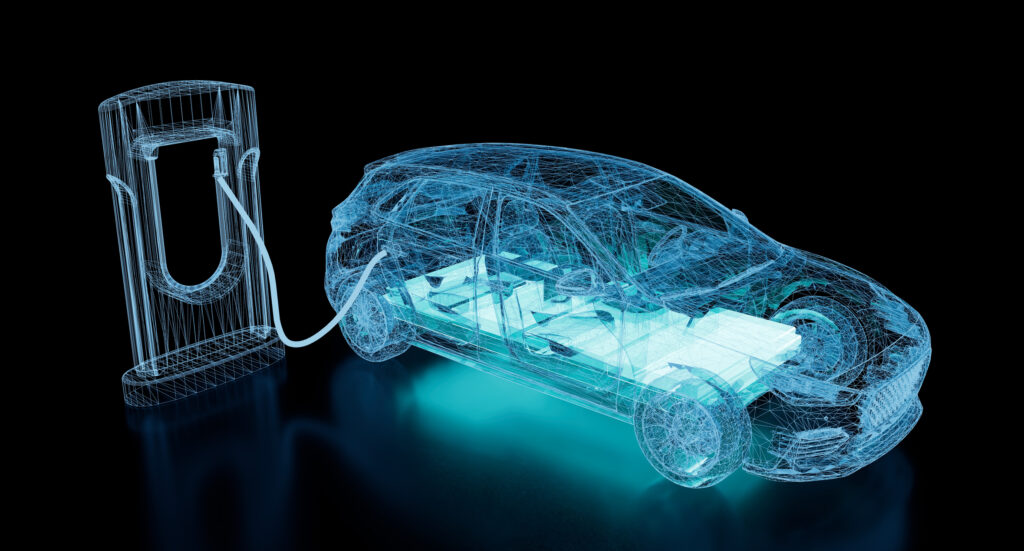
Technological advancements will evolve as we transition to a fully electric future, resulting in advanced, more efficient battery technologies. Increasing the efficiency of batteries is vital, not just for electric vehicles (EVs), but for the future of technology as a whole.
Diversifying battery material sourcing will prevent resource depletion and allow us to transition to a more U.S.-based supply chain, bolstering domestic manufacturing. This includes utilizing opportunities driven by both the Inflation Reduction Act and Bipartisan Infrastructure Law for consumer adoption and battery manufacturing alike.
Common Battery Chemistries Found in EVs
Most of today’s EVs and plug-in hybrids use two types of lithium-ion batteries chemistries— Nickel-Manganese or Iron Phosphate derivatives—which offer varying levels of energy storage and charging speed benefits depending on exact chemistry mix.
Lithium-Ion Batteries on the Road
Common battery chemistries in current deployment blend two or more types of battery metals together to provide improved energy density, longer life, and lower costs. Current popular options include:
- Nickel Manganese Cobalt (NMC): These batteries use a combination of nickel, manganese, and cobalt in the cathode, providing a good balance of energy density, power, and charging speed.
- Nickel Manganese Cobalt Aluminum (NMCA): These batteries are similar to NMC batteries but include aluminum, offering similar energy density and power performance levels.
- Lithium Iron Phosphate (LFP): These batteries use an iron-based cathode, allowing greater temperature flexibility (e.g. extreme cold and heat operation) and lower cost of production. They are less energy dense than NMC and NMCA batteries but have become popular for often being cheaper to produce.
As the battery market continues to grow to meet demand for greater distance and charging speed options, a variety of other battery designs and chemistries are also in development by vehicle manufacturers:
Solid-State Batteries
There are multiple efforts to increase research findings on solid-state batteries in the U.S. In September, the U.S. Department of Energy issued a $16 million lab call to strengthen domestic manufacturing of solid-state batteries, working to expedite the transition from innovation to manufacturing. Toyota Motor Corp and Idemitsu Kosan Co. recently announced they aim to offer solid-state batteries with over 900 miles of range in their vehicles. The U.S. is not far behind, with many start-ups already in production and the National Renewable Energy Laboratory (NREL) announcing its goal to achieve over 1,200 miles of range using solid-state batteries. These batteries use a solid electrolyte, which is more energy dense. Due to their structural integrity, solid-state batteries are significantly less susceptible to short-circuiting.
Graphene Batteries
Various energy and automaker partnerships have been pioneering advancements in graphene battery additions. Ramaco Carbon is partnering with Oak Ridge National Laboratory to boost technology to create U.S. graphene production from coal. Additionally, global automaker Stellantis has recently invested in Lyten, a startup known for their advanced lithium-sulfur batteries aided by graphene to prevent short-circuiting and make batteries more lightweight.
Graphene is a lightweight and more conductive material with a higher surface area compared to lithium, which can improve energy density, storage capacity, and charging speed. There are multiple applications of graphene that can produce these results, and graphene batteries may be more accessible to produce through 3D printing. The mechanisms for improving batteries through graphene include:
- Lowering charge time and increase energy capacity,
- High-performance electrodes for sodium-ion batteries, or
- High-rate LFP batteries, which have a structural combination that allows for excellent mechanical strength, electrical, and thermal conductivity, thus improving their power capability and cyclic stability, making them a top contender for future EV batteries.
Battery Application for Other Uses (Industrial, Utility, etc.)
Batteries have applications beyond transportation and are increasingly used for Industrial and Commercial applications, both as part of the manufacturing process for deeper electrification priority and for creating longer-term storage for renewable energy use.
Flow Batteries
Flow batteries use two chemical components in liquid, separated by a layer, allowing for recharging and discharging occurring by ion transfer. Often referred to as a redox battery, while lithium-ion batteries are a type of flow battery, other types have been found to store more energy and have more efficient storage, potentially lowering the overall cost. These batteries were initially created using vanadium, but due to the high cost of the critical mineral, researchers are studying cheaper alternatives that provide the same result.
Iron-Air Batteries
Form Energy, funded in part by Jeff Bezos and Bill Gates, is currently researching the widespread use of iron-air batteries. The power in iron-air batteries is generated by redox reactions involving iron and air electrodes. The composition of this battery allows for greater, cheaper energy storage than lithium-ion batteries and the discharge of generated electricity through a “reversible rusting” process (i.e., de-rusting). This process also prevents battery degradation, which is a key feature.
Lithium-Air Batteries
Lithium-air batteries use the oxidation of lithium at the anode and the reduction of oxygen at the cathode to induce a current flow. Pairing lithium and ambient oxygen can theoretically lead to higher energy densities than current lithium-ion batteries. As lithium-air batteries are undergoing experimentation, more research is needed to improve their design.
Sodium-Ion Batteries
These batteries use sodium ions instead of lithium ions, which can provide lower cost and comparable energy storage. Current development is utilizing different anodes to increase the capacity to that of a lithium-ion battery or greater before introducing it as a substitute within the EV market.
Thermal Batteries
A non-electric form of battery storage, thermal batteries that use the physics of heating material (concrete, salt, carbon) are attracting increased interest, especially for industrial or commercial processes that would have use for thermal applications. Heating of the material can come from direct solar radiation (e.g. reflective mirrors focusing sunlight) or electric resistance heating powered by renewable energy.
